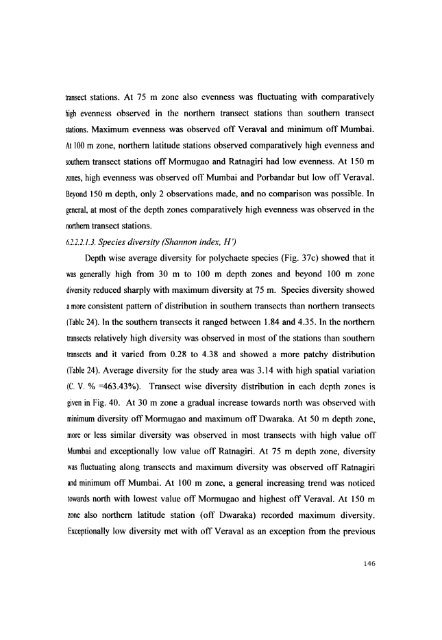L - Cochin University of Science and Technology
L - Cochin University of Science and Technology
L - Cochin University of Science and Technology
Create successful ePaper yourself
Turn your PDF publications into a flip-book with our unique Google optimized e-Paper software.
transect stations. At 75 m zone also evenness was fluctuating with comparatively<br />
high evenness observed in the northern transect stations than southern transect<br />
stations. Maximum evenness was observed otT Veraval <strong>and</strong> minimum otT Mumbai.<br />
At 100 m zone, northern latitude stations observed comparatively high evenness <strong>and</strong><br />
southern transect stations otT Monnugao <strong>and</strong> Ratnagiri had low evenness. At 150 m<br />
zones, high evenness was observed <strong>of</strong>f Mumbai <strong>and</strong> Porb<strong>and</strong>ar but low <strong>of</strong>f Veraval.<br />
Beyond 150 m depth, only 2 observations made, <strong>and</strong> no comparison was possible. In<br />
general, at most <strong>of</strong> the depth zones comparatively high evenness was observed in the<br />
northern transect stations.<br />
6.1.2.2.1.3. Species diversity (Shannon index, H')<br />
Depth wise average diversity for polychaete species (Fig. 37c) showed that it<br />
was generally high from 30 m to 100 m depth zones <strong>and</strong> beyond 100 m zone<br />
diversity reduced sharply with maximum diversity at 75 m. Species diversity showed<br />
a more consistent pattern <strong>of</strong> distribution in southern transects than northern transects<br />
(Table 24). In the southern transects it ranged between 1.84 <strong>and</strong> 4.35. In the northern<br />
transects relatively high diversity was observed in most <strong>of</strong> the stations than southern<br />
transects <strong>and</strong> it varied from 0.28 to 4.38 <strong>and</strong> showed a more patchy distribution<br />
(Table 24). Average diversity for the study area was 3.14 with high spatial variation<br />
(C. V. % =463.43%). Transect wise diversity distribution in each depth zones is<br />
given in Fig. 40. At 30 m zone a gradual increase towards north was observed with<br />
minimum diversity otT Monnugao <strong>and</strong> maximum otT Dwaraka. At 50 m depth zone,<br />
more or less similar diversity was observed in most transects with high value <strong>of</strong>f<br />
Mumbai <strong>and</strong> exceptionally low value <strong>of</strong>f Ratnagiri. At 75 m depth zone, diversity<br />
was fluctuating along transects <strong>and</strong> maximum diversity was observed <strong>of</strong>f Ratnagiri<br />
<strong>and</strong> minimum otT Mumbai. At 100 m zone, a general increasing trend was noticed<br />
towards north with lowest value otT Monnugao <strong>and</strong> highest otT Veraval. At 150 m<br />
zone also northern latitude station (<strong>of</strong>f Dwaraka) recorded maximum diversity.<br />
Exceptionally low diversity met with otT Veraval as an exception from the previous<br />
146

















